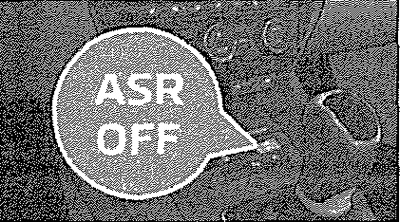Carefully! If the ABS fails, the ESC, ASR and EDS systems also do not work. ABS fault is displayed contr.lamp.
Stability Program (ESC)
Esc key
The ESC system improves control over the vehicle in extreme dynamic conditions, for example, when changing direction abruptly. Depending on the road conditions, the risk of skidding is reduced and thus the vehicle stability is increased. The ESC system is automatically activated each time the ignition is turned on.

The system monitors the steering angle and vehicle speed set by the driver and constantly compares them with the actual driving characteristics of the vehicle. If discrepancies are detected, for example, when the vehicle goes into a skid, the ESC system automatically brakes the corresponding wheel. When the control system is activated the
Enable/Disable ASR
The ASR function in the ESC can be deactivated/activated in the infotainment system or via the button.
Short press the
5 counter lights up in the instrument cluster. lamp, the following message appears on the display: «M» Antiprobuksov. system (ASR) off. «E» ASR OFF
Press the key again.
The indicator lamp in the instrument cluster goes out and the following message appears on the display: «M» Antiprobuksov, ASR system included. «5» ASR ON
Enable/Disable ESC Sport
The ESC Sport function in the ESC can be activated/deactivated via the infotainment system or via the button.
ESC Sport is a mode suitable for a sporty driving style. When ESC Sport is switched on, the ASR system is switched off. The EEC system reacts with a delay so as not to: interfere with driving in a sporty manner. Press and hold the key for a while.
The indicator light in the instrument cluster is on. lamp, the following message appears on the display: «M». ESC Sport: courses, stable. limited. «S» ESC SPORT.
Press the key again.
The indicator lamp in the instrument cluster goes out and the following message appears on the display: «M» ESC (stability control system) included. «S» ESC ON
Carefully! When you turn on the ESC mode, the ASR system will automatically turn off. Therefore, some other functions may work with limitations.
Anti-lock braking system (ABS)
ABS prevents the wheels from locking up when braking. This helps the driver maintain control of the vehicle. The adjustment process is accompanied by pulsation of the brake pedal and noise. When the ABS is activated, neither intermittent braking nor loosening the pressure on the brake pedal should be performed.
Anti-slip system (ASR)
ASR key

In the event of wheel spin, ASR adapts the engine speed to the road conditions. In unfavorable road conditions, ASR facilitates starting, accelerating and driving uphill. Each time the ignition is switched on, the ASR is activated automatically. If your vehicle is equipped with an ESC system, the ASR traction control system is integrated into the ESC system. When the system is triggered, the counter flashes. ASR lamp
When the ASR is switched off, the counter lights up in the instrument cluster. lamp
Electronic differential lock (EDS and XDS)
EDS
When the drive wheel slips, EDS slows down the slipping wheel and thereby transfers torque to the other drive wheels. This increases the stability and dynamics of the vehicle. To prevent the disc brakes of the braked wheel from overheating, the EDS is automatically disabled. All other vehicle systems remain in working order as in the same vehicle without EDS. As soon as the temperature of the brakes drops, the EDS system will automatically turn on.
XDS
The XDS function is an addition to the electronic differential lock. XDS does not respond to slip, but to the unloading of the wheel of the drive axle, which is closer to the center of the turn, at high speed in the turn. Thanks to the automatic activation of the brakes of an unloaded wheel, its slippage is prevented. This improves grip on the road and helps stabilize the vehicle.
Active Steering Assist (DSR)
The DSR function provides the driver with steering recommendations to help stabilize the vehicle in critical situations. The steering assistant is activated, for example, during heavy braking, when the road surface under the right and left wheels is different.
Brake assistant (NVA)
It improves braking performance and helps shorten the stopping distance. The brake assistant is activated when the brake pedal is pressed hard. To ensure the minimum possible braking distance, the brake pedal must be pressed all the way until the vehicle comes to a complete stop. When the brake pedal is released, the brake assist automatically stops. During the operation of the brake assistant, the ABS works faster and more efficiently.
Hill start assistant (NNS)
NNS allows you to move your foot from the brake pedal to the gas pedal when starting off on an incline, without holding the car with the parking brake. The system maintains pressure in the brake system for 2 seconds after the brake pedal is released. The pressure in the brake system drops gradually as the driver presses the gas pedal. If the driver does not start off within 2 seconds, the vehicle will begin to roll backwards. The hill start assistant is activated on slopes steeper than 5%, provided that the driver's door is closed. It is only activated when driving off on a hill, both when driving forward and when reversing. When driving downhill, it does not activate.
Emergency braking function
Initiates automatic braking after a collision to reduce the risk of repeated collisions. Automatic braking can only be carried out at speeds above 10 km/h, in the event of a frontal or side collision. The vehicle is braked automatically, using the ESC system, until the brakes, the ESC system, as well as the necessary el. equipment remain operational after a collision. If the driver presses the brake pedal during an accident, the automatic braking function will not work.
